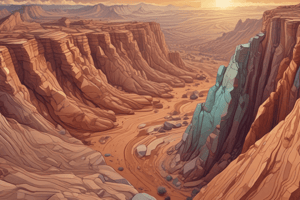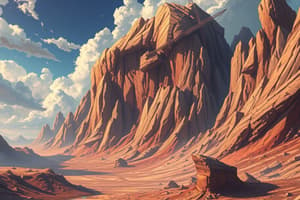Podcast
Questions and Answers
What is the significance of Bowen's reaction series in explaining igneous mineral and textures?
What is the significance of Bowen's reaction series in explaining igneous mineral and textures?
It forms the basis for explaining igneous mineral and textures
What determines the texture of an igneous rock?
What determines the texture of an igneous rock?
The temperature of the cooling magma
How do igneous rocks differ based on their composition?
How do igneous rocks differ based on their composition?
By their silica content, resulting in mafic, felsic, or ultra-mafic rocks
What is the term for the original rock before metamorphism?
What is the term for the original rock before metamorphism?
What is the difference between low-grade and high-grade metamorphic rocks?
What is the difference between low-grade and high-grade metamorphic rocks?
What factor determines the colour of an igneous rock?
What factor determines the colour of an igneous rock?
What is the significance of magma chemistry in igneous rock formation?
What is the significance of magma chemistry in igneous rock formation?
What is the difference between intrusive and extrusive igneous rocks?
What is the difference between intrusive and extrusive igneous rocks?
What is a rock and how is it defined?
What is a rock and how is it defined?
Why do sedimentary rocks make up the majority of the Earth's crust?
Why do sedimentary rocks make up the majority of the Earth's crust?
What are the three processes that can cause the melting of rocks to form magma?
What are the three processes that can cause the melting of rocks to form magma?
What is the main difference between plutonic and volcanic igneous rocks?
What is the main difference between plutonic and volcanic igneous rocks?
What is the name of the process by which rocks are formed, transformed, and destroyed?
What is the name of the process by which rocks are formed, transformed, and destroyed?
What are the three main categories of rocks based on their process of formation?
What are the three main categories of rocks based on their process of formation?
Why is it important to study rocks and the rock cycle?
Why is it important to study rocks and the rock cycle?
What is the term for the solidification and cooling of magma to form rocks?
What is the term for the solidification and cooling of magma to form rocks?
Flashcards are hidden until you start studying
Study Notes
What is a Rock?
- A rock is a naturally occurring solid cohesive aggregate of one or more mineral or mineral materials.
- There are three main rock types: igneous, sedimentary, and metamorphic rocks.
Importance of Rocks
- Sedimentary rocks make up 66% of the Earth's crust, with 34% being igneous and metamorphic.
- Igneous rocks form the majority of the 34%.
- Sedimentary rocks are mainly found on ocean floor basins, which account for 70% of the total area of the Earth.
Igneous Rocks
- Formed from the solidification and cooling of magma, which can be derived from partial melts of pre-existing rocks in either a planet's mantle or crust.
- Melting of rocks is caused by an increase in temperature, a decrease in pressure, or a change in composition.
- Divided into two main categories: plutonic (intrusive) rock and volcanic (extrusive).
- Plutonic rocks result from magma cooling and crystallizing slowly within the Earth's crust, e.g., granite.
- Volcanic rocks result from magma reaching the surface either as lava or fragmental ejecta, e.g., pumice or basalt.
- Bowen's reaction series explains the sequence of crustal formation and forms the basis for explaining igneous mineral and textures.
- Can be differentiated according to their texture, color, and composition depending on the environment of deposition and the chemistry of magmas.
Texture of Igneous Rocks
- Determined by the temperature of the cooling magma.
- Slow cooling: large crystals form, phaneritic texture.
- Fast cooling: small crystals form, sometimes a glassy texture where no minerals form.
Color of Igneous Rocks
- Determined by its dominant minerals.
- Dark minerals form mafic rocks, while lighter colored minerals form felsic rocks due to fractionation during magma cooling.
Metamorphic Rocks
- Formed due to high pressure and temperature below the zone of diagenesis.
- Protolith refers to the original rock, prior to metamorphism.
- Original textures are often preserved in low-grade metamorphic rocks, allowing one to determine the likely protolith.
- Grade of metamorphism increases with pressure and temperature.
Studying That Suits You
Use AI to generate personalized quizzes and flashcards to suit your learning preferences.




